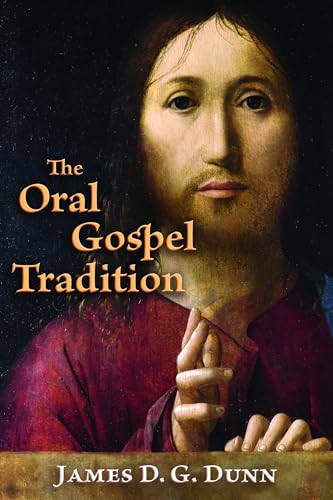This excellent book is a collection of fifteen essays previously published by Dunn, mostly in the wake of Jesus Remembered (pp. vii-viii), although three do predate that volume: “Prophetic ‘I’-Sayings and the Jesus Tradition” (1978); “John and the Oral Gospel Tradition” (1991); and “Matthew’s Awareness of Markan Redaction” (1992). Overall, the collection is historically stimulating and Dunn’s appreciation for the liveliness of oral traditioning is on display throughout. He frequently emphasizes both communal and performative aspects of oral traditioning, and includes an essay on “Social Memory and the Oral Jesus Tradition” (pp. 230–47).
The book is divided into three parts, thematically arranged, with Part I mostly comprised of essays on Gospel pre-history or the Gospels themselves (including two essays on John’s Gospel, pp. 138–63 and 164–95). Part II focuses on present research related to Dunn’s oral emphasis and engages Dunn’s interlocutors, including Bengt Holmberg and Samuel Byrskog (pp. 199–212), Birger Gerhardsson and Richard Bauckham (pp. 213–29), and Theodore Weeden, who firmly critiques Kenneth Bailey’s model that Dunn relies heavily upon (pp. 248–64). Part III’s essays involve more syntheses of Dunn’s overall contributions and are excellent resources, specifically “The History of the Tradition (New Testament)” (pp. 313–63), which is the clearest and briefest though comprehensive treatment of Dunn’s thinking on oral tradition available.
Fundamental for Dunn is his concern to alter “the default setting” of Gospel criticism, from the stratified and composition-laden “literary paradigm,” i.e., form criticism’s continued and undue influence (pp. 44–49), to one more welcoming and appreciative of the oral culture surrounding the development of the Gospel tradition (pp. 49–59), and the tradition’s own lively character (p. 79; Dunn does not, however, dismiss the two-document hypothesis, p. 61). Although he does not dispense with Q, the oral traditioning model, according to Dunn, has better explanatory power than the literary paradigm in accounting for the same-yet-different character of the Jesus tradition (p. 59). On the heels of this essay, Dunn presents “Q1 as Oral Tradition” (pp. 80–108). Here Dunn ably demonstrates the varied character of the six clusters of wisdom sayings (seventeen examples) identified as Q1 by John S. Kloppenborg with telling insight for his oral thesis of the tradition, concluding, against Kloppenborg, that the evidence for “a discrete compositional unit or stratum is weak” (p. 107).
Dunn has long been intrigued with Bailey’s thesis of informally controlled tradition, and this collection of essays reprints his rebuttal of Weeden (pp. 248–64). Dunn prefers Bailey’s model over Gerhardsson’s better-attested “model of rabbinic traditioning” due to the rabbinic model’s “formal and even regimented process” (p. 249), something Dunn feels cannot account for attested variation. Neither does Dunn find much value in folkloristics (p. 249), in contrast to his student, Terence C. Mournet, who is more appreciative. Dunn’s response to Weeden’s critique of the haflat samar leaves much to be desired, since Weeden firmly showed that the practice was akin to evening entertainment (see pp. 251–52, n. 9). When Dunn explains that Rena Hogg’s book, which was used by Bailey to demonstrate the stability of traditioning, is not actually traditioning material (pp. 251–53), he is on firmer ground. Both Bailey and Weeden make the mistake of casting Rena Hogg as a tradent, since both presuppose that her book provides a crystallization of the same traditioning process that was accessible to Bailey. Her account, however, was not a representation of village tradition, but a memoir about her father. Dunn’s response may have fared better in emphasizing this rather than suggesting contextual differences in hafalat samar traditioning.
In his discussion with Bauckham (pp. 213–29, esp. 222–29), Dunn reveals that both he and Bauckham have different understandings of Gospel pre-history, though they can and should be taken as complementary (as I. Howard Marshall notes, in “A New Consensus on Oral Tradition? A Review of Richard Bauckham’s Jesus and the Eyewitnesses,” Journal for the Study of the Historical Jesus 6 [2008]: 190). If, as Dunn writes, Bauckham “wants the eyewitnesses themselves to bridge the gap between initial formulation and transcription in written Gospels, he may be pressing his case beyond the evidence as it has come down to us” (p. 227). But this ignores the significance of Luke’s prologue and specified tradents (see Bauckham, Jesus and the Eyewitnesses [Grand Rapids: Eerdmans, 2006], 34n71; also noted by Marshall), who are just one link in the chain of transmission removed from Luke’s account. Dunn’s rich and lively historiography needs more of the complementary project of eyewitness traditioning to assist in offering stability in the similar-yet-dissimilar character of the tradition.
In closing, Dunn’s work on orality is remarkable in the greatest sense of the word. It brings a richness to the text that is seldom accentuated so expertly. Gospel history and liturgy are illuminated in new and rich ways that open up imaginative historical vistas. Dunn’s work deserves appreciation and thankfulness from any student interested in Gospel pre-history.
Michael Metts
Michael Metts
University of Aberdeen
Aberdeen, Scotland, UK
Other Articles in this Issue
This article considers the emergence of an evangelical endorsement of the Two-Source Hypothesis as a solution to the Synoptic Problem in the first half of the twentieth century...
Brian Simmons has made a new translation of the Psalms (and now the whole New Testament) which aims to ‘re-introduce the passion and fire of the Bible to the English reader...
Nearly three hundred fifty years after Martin Luther nailed the 95 Theses to the castle church door in Wittenburg, Charles Haddon Spurgeon confronted the growing influence of Roman Catholic teaching within the Church of England...
A Theological Sickness unto Death: Philip Rieff’s Prophetic Analysis of our Secular Age
by Bruce Riley AshfordPhilip Rieff’s sociological analyses explore the implications of Western Civilization’s unprecedented attempt to maintain society and culture without reference to God...
The giant of Old Princeton, B. B. Warfield, outspokenly condemned the racism and rigid segregation of American society of his day...







